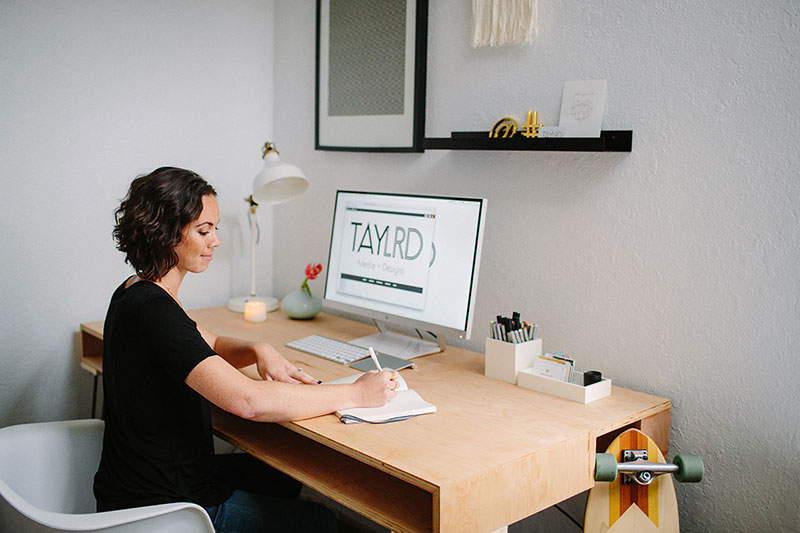Pinterest is more than a place to share inspiration. For a business, it’s a powerful search engine that works around the clock to put your content in front of the right people at the right time.
When used strategically, Pinterest for business becomes a marketing hub that builds visibility and drives traffic long after you hit publish. The problem is that without a clear workflow, even the best intentions can turn into scattered posting, inconsistent branding, missed opportunities, and burnout.
Pinterest plays by different rules than Instagram or Facebook. It requires a long-term approach, a focus on search keywords, and consistency to see results. Add in an ever-changing algorithm, and it’s easy to see why so many give up too soon.
With the right Pinterest strategy and a central system to manage it all, Pinterest can quietly run in the background of your business. For me, that system includes Enji. It keeps my planning, pin designs, scheduling, captions, and metrics streamlined so I’m not juggling half a dozen platforms.
In this guide, I’ll walk you through a step-by-step Pinterest workflow you can set up today using Enji alongside Canva and Google Sheets. You’ll learn how to:
- Build a content plan backed by Pinterest keywords and trends
- Design branded pins that get clicks
- Automate your scheduling and captions
- Track performance so your results keep growing
TL;DR: Use this Pinterest workflow to make marketing your small business on Pinterest easier:
Research keywords → Design in Canva → Create captions with Enji → Schedule pins with Enji → Review metrics with Enji → Adjust strategy

Cinthia is a Systems and Marketing Strategist and the founder of Boda Bliss. She partners with wedding professionals and creative entrepreneurs to design sustainable marketing systems, streamline operations, and implement workflows that increase visibility and efficiency. Pinterest is one of the key platforms she helps clients manage, using it as part of a larger strategy to create a marketing hub that works in the background. Her practical, results-driven approach equips clients to manage their marketing with clarity and confidence, creating space for long-term growth.
Step 1: Build Your Pinterest Workflow Foundation with a Keyword Tracker
Every good marketing plan starts with data. Pinterest is no different.
Most people skip keyword research or lose track of what they’ve already pinned. The result? Half-finished boards, inconsistent posting, and a loss of momentum. A keyword tracker keeps everything in one place so you can stay organized and consistent long-term.
I recommend creating a Pinterest keyword tracker in Google Sheets. Here’s what to include:
- Main keyword for each pin
- Supporting keywords for extra context
- Long-tail keywords for niche searches
- Text overlay ideas
- Pin descriptions
- Board name and date pinned
- Source link
You can find keywords through:
- Pinterest search bar suggestions
- Related searches on Pinterest
- Pinterest Trends
- Google Trends for seasonal crossover ideas
What keywords should I use in my Pin titles and descriptions?
Start with your main keyword: Pick something broad that clearly says what your content is about.
Example: “Green weddings.”
Add a few related keywords: Choose words that give Pinterest more context and help your pin show up in different searches.
Example: “Eco-friendly weddings” or “Green wedding décor.”
Use long-tail keywords: Get more specific with phrases that describe exactly what someone might be searching for.
Example: “Green wedding centerpiece ideas” or “Eco-friendly fall wedding decorations.”
Think like your audience: Ask yourself what your couple or client would type into Pinterest if they were looking for inspiration.
Example: “How to plan a green wedding on a budget” or “Fall wedding with greenery theme.”
Keep it natural: Your keywords should fit into a sentence that makes sense, not just a list of random words.
Example: Instead of “green, wedding, fall décor,” write “Ideas for green wedding décor in the fall.”
Lean into action words: Use keywords that show someone is ready to do something or take the next step.
Example: “Download green wedding checklist” or “Shop greenery wedding invitations.”
Stay seasonal and on trend: Layer in keywords that make your pins timely and relevant.
Example: “Green wedding color palettes for fall” or “Greenery wedding trends 2025.”
Work in your brand name when it fits: This helps your pins become recognizable over time.
Example: “Green wedding ideas by Boda Bliss” or “Fall greenery wedding guide with Boda Bliss tips.”
Use keyword tools to spark ideas: Pinterest’s search bar, Pinterest Trends, and PinClicks will show you what people are actually typing in.
Example: Typing “green wedding” might bring up “green wedding invitations” or “green and gold wedding décor.”
Pro tip: PinClick is another great tool for finding high-performing Pinterest keywords.
Free Resource: Start your Pinterest strategy with my ready-to-use Pinterest Keyword Tracker in Google Sheets. It’s designed to help you map out a month of pins in under 30 minutes, so you can post with purpose instead of guessing. Download the free tracker.
Step 2: Design Scroll-Stopping Pins in Canva
Pinterest is all about visuals, so your pins need to catch someone’s eye right away. When people are scrolling, you only have a second to make them pause and want to click. The fun part is there are different types of pins you can use, and each one has its own way of helping you get noticed.
How do I design Pins that get clicks and saves?
There are 5 things you should do to design pins that get clicks and saves.
Know the main types of pins for Pinterest and use a mix
- Standard Pins: Classic vertical images that link directly to your content.
- Video Pins: Short clips that play automatically in the feed and work great for tutorials or quick tips.
- Idea Pins: Multi-page, tappable pins that combine images, videos, and text. They don’t link out, but they’re amazing for building saves and engagement.
- Rich Pins: Pins that pull details straight from your website, like titles, prices, or recipes, so everything stays up to date.
Using a mix of these pin types helps you reach people in different ways and keeps your content feeling fresh.
Create pins with high-quality, engaging images
- Use clear, crisp, well-lit photos.
- Avoid generic stock images when you can. Photos that feel real and personal usually perform better.
- Focus on one subject so your pin is easy to understand at a glance.
- Bright, bold colors often stand out the most in the feed.
Use easy-to-read text overlay
- Add a short title or phrase right on the image so people know what the pin is about instantly.
- Choose fonts that are big and easy to read on both desktop and mobile.
- Pick colors that contrast with your background so the text pops.
- Keep it short and simple so the message comes through fast.
Make sure your pins are branded
- Add your logo or website link in a corner to build recognition.
Stick to the same fonts, colors, and style across your pins so they feel consistent and easy to spot.
Use strategic headlines and call-to-actions
- Write headlines that spark curiosity or promise a quick win.
- Highlight the benefit people will get when they click.
- Use a gentle call-to-action like “Click to read more” or “Get the free guide” so they know the next step.
- Infographics and collages work really well for saves because they pack a lot of value into one pin.
When your designs are ready, Canva makes it simple to keep things consistent. And with Enji’s integration, you can send pins straight from Canva into your scheduler without extra steps.
Step 3: Turn Keywords into Pinterest Captions with Enji’s AI Copywriter
Captions can take time to create, even when you already have a list of keywords, know the topic, and have your call-to-action ready. On average, it used to take me 10–15 minutes to write just one caption. If I was posting five pins a day for a whole month, that added up to more than 30 hours of caption writing. Now with Enji’s AI Copywriter, I can draft a caption in about two minutes. What used to feel like a huge time drain now takes only a few hours total each month.
Enji’s built-in AI Copywriter helps you turn your keyword research into first-draft captions in seconds.
Here’s why it works:
- It uses your brand voice so captions feel authentic
- You can adjust tone for different audience types
- Drafted captions can be scheduled directly to Pinterest without leaving Enji
Pro tip: Enji added a feature that makes it easy to create great pin titles and descriptions with AI and no prompting. Just copy and paste the URL of the page you want to pin, hit “draft it for me,” and Enji will read the content and generate a title and description for you. You still add your personal touch, but the heavy lifting is already done.
Should keywords go in the title, the description, or both?
The best approach is to use them in both. Your title and description work together to help Pinterest understand what your pin is about.
- Add your main keyword in the title so it’s clear right away.
- Use related or long-tail keywords in the description to give Pinterest more context and help your pin show up in extra searches.
- Keep a natural flow in your writing. Keywords should feel like part of a normal sentence, not a list of random words.
- Don’t forget the file name. When you save your image, rename it with a keyword instead of leaving it as “IMG_1234.” This small step gives Pinterest another clue about your content.
Using keywords in all of these places makes your pins easier to find without sacrificing readability for your audience.
Step 4: Schedule your pins to post with Enji’s Social Media Scheduler
Creating pins is only half the work. Getting them posted is what keeps your strategy moving. The good news is you do not need to be inside Pinterest every single day manually pinning. A scheduler lets you batch your work, stay consistent, and save time.
What tools can I use to schedule Pins (and is Tailwind the only option)?
I love using Enji’s Social Media Scheduler to schedule pins. And no, Tailwind is not the only option. With Enji, you can:
- Schedule as many pins as you want with no limits
- Batch your content so you can work weeks or even months ahead
Keep your Pinterest posts in the same place as your other marketing tasks - Stay consistent without logging in every day
My favorite scheduling tips
- Research keywords 3 months at a time since Pinterest pins are designed to be discovered in the future when trends are coming up
- Batch your pins weekly or monthly to stay ahead and save hours
- Use a mix of pin types to keep your feed interesting and engaging
- Spread out your pins instead of posting everything at once to create steady activity
- Check in weekly to review your queue and make small adjustments if needed
Scheduling is the step that pulls everything together. Once you have researched your keywords, designed your pins, and written your captions, scheduling makes sure your work actually gets out into the world consistently without taking over your time.
Step 5: Track and Celebrate with Enji’s Performance Feature and KPI Day
How do I know if my Pins are performing well?
If you want to know if your pins are performing well, you can log into your Pinterest account to look at things, but looking at individual pin performance isn’t the only thing you need to do. You should also be tracking metrics that help you understand how your Pinterest account is performing as a whole. Because if you aren’t, you’re running on guesswork and potentially wasting a lot of time and energy on pins that do nothing.
Enji’s KPI Dashboard gives you a clear view of the metrics that matter most for your business so you can make informed decisions instead of relying on hunches. More on that in just a moment.
For Pinterest, the most important metrics for you to track include:
- Impressions – how many times your pin appeared in feeds or searches
- Pin Clicks – how many people viewed your pin close-up
- Outbound Clicks – how many clicked through to your site
- Saves – how many saved your pin for later
Looking at these regularly helps you see what is working and where to tweak your strategy:
- High impressions but low clicks? That usually means your pin is showing up in searches but not grabbing attention. Adjust your title, text overlay, or design to make it more clickable.
High clicks but low saves? People are curious enough to look, but maybe the content or design isn’t something they want to revisit. This is a cue to refine your visuals or add more value. - High saves? You have found a topic or style your audience loves. Create more content around it because saves are a strong signal to Pinterest that your content is worth showing to more people.
- High outbound clicks? This is the gold standard. It means your pins are driving real traffic back to your site. Track which types of content and keywords are leading to those clicks so you can repeat and scale what works.
What this helps you do
- Plan future content around the styles and topics that perform best
- Save time by focusing only on the strategies that bring results
- Confidently adjust your designs, captions, or keyword focus instead of guessing
- Turn Pinterest into a steady traffic source that grows over time
And because tracking your Pinterest analytics shouldn’t feel like a chore, Enji has KPI Day—a monthly celebration in the Enji community! On the first day of every month, Enji will automatically track your Pinterest metrics (if you’ve set up the integration),and Enji will send a reminder to review your results.It’s a fun way to turn performance review into a win, making metrics something to look forward to instead of a task you keep pushing off.
If you’re a wedding professional and want to go deeper into tailoring your boards and content for your niche, my post on Pinterest for wedding pros is a great place to start.
How should I adjust my Pinterest strategy based on what the numbers say?
How should I adjust my strategy based on what the numbers say?
- When impressions are high but clicks are low
People are seeing your pins, but they are not drawn in enough to click. Try fresh designs, a clearer title, or a stronger text overlay that makes them curious. - When clicks are high but saves are low
Your pins are getting attention, but they are not something people want to come back to later. Add more value right on the pin, like a quick tip or checklist, so it feels worth saving. - When saves are high
You have struck a chord. Your audience loves this topic or style, so keep going. Create more pins in this category and test a few new angles around the same theme. - When outbound clicks are low
People like your pin, but they are not moving over to your site. Check that your description and call to action are clear and that the page you link to delivers exactly what the pin promises. - When outbound clicks are high
This is what you want. Pay attention to what these pins have in common, whether it is the topic, keywords, or design. Use those insights to shape your next batch of pins.
Looking at your numbers is not just about data. It is about learning what your audience cares about so you can keep creating pins that work harder for you.
A Solid Pinterest Marketing Workflow Helps You Get More From Your Effort
With the right workflow, Pinterest stops being a time-intensive guessing game and becomes a consistent, long-term traffic source for your business. By organizing your process across tools like Google Sheets, Canva, and Enji, you’ll know exactly what to post, when to post it, and how to measure success.
Instead of wondering if your efforts are paying off, you’ll have a clear plan that works quietly in the background freeing you up to focus on other parts of your business. Start your free trial of Enji here and see how simple Pinterest marketing can be.





